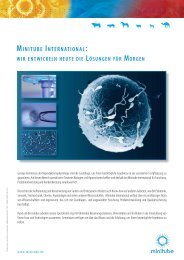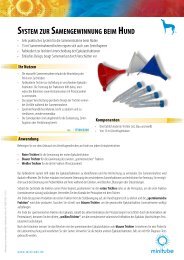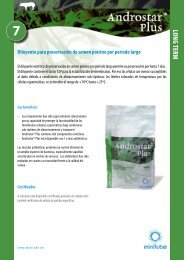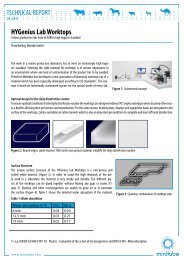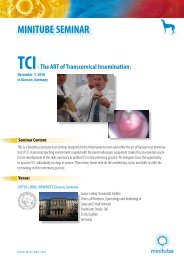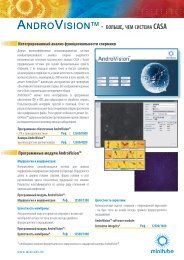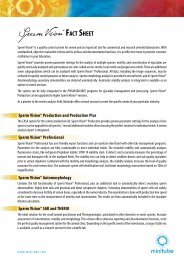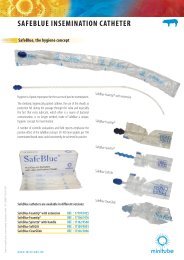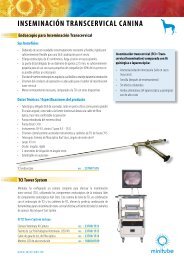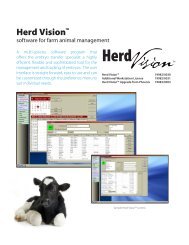MPP Quattro: a filling and sealing machine designed for best semen ...
MPP Quattro: a filling and sealing machine designed for best semen ...
MPP Quattro: a filling and sealing machine designed for best semen ...
Create successful ePaper yourself
Turn your PDF publications into a flip-book with our unique Google optimized e-Paper software.
SpermNotes<br />
Bovine Semen Production:<br />
New Options Offered by<br />
Minitüb<br />
Over the last 3 years, Minitüb<br />
has developed a completely<br />
new product line <strong>for</strong> modern bovine<br />
<strong>semen</strong> production laboratories.<br />
With engineering <strong>and</strong> veterinarian<br />
competence of 35 years, our specialized<br />
team has concentrated<br />
on the real needs of today‘s <strong>semen</strong><br />
production: <strong>best</strong> usage of valuable<br />
cells, high degree of precision in cell<br />
quantity <strong>and</strong> quality determination,<br />
high level of security in identification<br />
<strong>and</strong> full traceability of <strong>semen</strong> doses,<br />
<strong>MPP</strong> <strong>Quattro</strong>: a <strong>filling</strong> <strong>and</strong> <strong>sealing</strong> <strong>machine</strong><br />
<strong>designed</strong> <strong>for</strong> <strong>best</strong> <strong>semen</strong> usage<br />
The <strong>MPP</strong> <strong>Quattro</strong><br />
is a fully<br />
automatic <strong>filling</strong><br />
<strong>and</strong> <strong>sealing</strong><br />
<strong>machine</strong><br />
<strong>for</strong> 0.25 cc <strong>and</strong><br />
0.5 cc <strong>semen</strong><br />
straws. It simultaneously<br />
fills <strong>and</strong><br />
seals 4 straws<br />
per one-second<br />
cycle which<br />
equals approximately<br />
15.000<br />
straws per hour.<br />
The <strong>MPP</strong> <strong>Quattro</strong><br />
is equipped<br />
with a modern<br />
touch screen <strong>and</strong> well-<strong>designed</strong><br />
user interface that guarantees optimal<br />
<strong>machine</strong> operation <strong>and</strong> minimum<br />
maintenance. Since the first<br />
<strong>machine</strong>s have been installed in<br />
The International AI Newsletter from Minitüb<br />
No. 10/2005<br />
excellent efficiency of laboratory<br />
time spent <strong>and</strong> maximum technical<br />
reliability. This special edition of the<br />
Minitüb SpermNotes concentrates<br />
on technical features of our equipment<br />
<strong>for</strong> bovine <strong>semen</strong> production.<br />
Additional in<strong>for</strong>mation is available in<br />
our catalogs <strong>and</strong> on our webpage<br />
www.minitube.de. The Minitüb customer<br />
service team is available at<br />
any time <strong>for</strong> individual consulting.<br />
the industry, one year ago, the ever<br />
growing dem<strong>and</strong> <strong>and</strong> many different<br />
labs <strong>and</strong> operators helped to gather<br />
a lot of experience about the most<br />
important features of this <strong>machine</strong><br />
from the user’s perspective:<br />
SpermNotes 10/2005 homepage: www.minitube.de<br />
MINITÜB<br />
Hauptstraße 41 . 84184 Tiefenbach<br />
Germany<br />
Tel.: +49-(0)8709- 92 29 - 0<br />
Fax: +49-(0)8709- 92 29 - 39<br />
E-mail: minitube@minitube.de<br />
<strong>MPP</strong> <strong>Quattro</strong>...................................1<br />
MiniJet straw printer.......................4<br />
Volume measurement...................6<br />
Advances with Andromed ® ..........7<br />
Intrauterine insemination...............8<br />
Integrated <strong>semen</strong> processing<br />
with IDENT <strong>and</strong> IDA........................ 9<br />
Appointment Dr. Sieber................11<br />
I<br />
CONTENT<br />
The unique design of the straw transport<br />
is a very characteristic feature.<br />
The star design ensures precise positioning<br />
of the straws at the various<br />
work stations, it is wear <strong>and</strong> tear free<br />
<strong>and</strong> due to its low mass the <strong>machine</strong><br />
1
2<br />
Bovine Semen Production<br />
is very quickly adapted to 5°C working<br />
ambient.<br />
The changeover from 0.25 cc to<br />
0.5 cc straws or vice-versa does not<br />
require the exchange of components<br />
<strong>and</strong> is carried out by simple<br />
mechanic adjustments within only<br />
few seconds: the 0.25 cc straws use<br />
the small grooves whereas <strong>for</strong> 0.5 cc<br />
straws the large grooves of the supply<br />
wheel are open <strong>and</strong> the small ones<br />
are blocked.<br />
However, the most outst<strong>and</strong>ing feature<br />
of this <strong>machine</strong> is the automatic<br />
recognition of low ejaculate volume.<br />
The current ejaculate is placed on a<br />
spring balance which is incorporated<br />
in the <strong>machine</strong>. The balance sensor<br />
system of the <strong>MPP</strong> <strong>Quattro</strong> constantly<br />
records the ejaculate weight <strong>and</strong><br />
recognizes when it is close to coming<br />
to its end. Then the <strong>machine</strong> automatically<br />
initiates a changeover from<br />
4 straws to 1 straw per cycle <strong>filling</strong>.<br />
At the same moment, all three idle<br />
nozzles <strong>and</strong> hoses are left open, so<br />
that the <strong>semen</strong> from the 3 unused<br />
<strong>filling</strong> nozzles <strong>and</strong> hoses flows back<br />
into the ejaculate container. The<br />
remaining nozzle fills single straw by<br />
single straw until a sensor detects an<br />
air bubble in its hose. Then the supply<br />
from the straw hopper is stopped <strong>and</strong><br />
only the straws that are already in the<br />
Semen bottle with cone-bottom to<br />
catch the last drop of <strong>semen</strong>, along<br />
with holder<br />
Adjustable scale-plat<strong>for</strong>m<br />
production cycle are finished to be<br />
processed. After that, the <strong>machine</strong><br />
stops. This procedure ensures the<br />
complete use of the ejaculate up<br />
to the very last drop. Practically no<br />
<strong>semen</strong> <strong>and</strong> no straws are wasted.<br />
How important is this feature? A<br />
simple calculation shows the eco-<br />
4 straw operation<br />
1 straw operation<br />
nomic benefit: with a normal 4-cycle<br />
<strong>machine</strong>, the last 4 or 8 straws are<br />
not completely filled <strong>and</strong> have to<br />
be thrown away. If calculating an<br />
average of only 4 wasted half full<br />
0.5cc straws per ejaculate, 10 ejaculates<br />
per production day, <strong>and</strong> only 2<br />
production days per week, with an<br />
average value of 5 EUR per <strong>semen</strong><br />
straw, the benefit from this feature is<br />
SpermNotes 10/2005 homepage: www.minitube.de<br />
Selector <strong>for</strong><br />
0.25 cc or<br />
0.5 cc straws<br />
Ring <strong>for</strong><br />
selection of<br />
4-3-2-1 straws<br />
per cycle<br />
Small grooves<br />
<strong>for</strong> 0.25 cc,<br />
big grooves<br />
<strong>for</strong> 0.5 cc,<br />
2000 extra produced <strong>semen</strong> doses or<br />
10.000 EUR extra turn-over value per<br />
year.<br />
The st<strong>and</strong>ard operation processes<br />
4 straws per cycle, but the user can<br />
also select a software-driven 1 straw<br />
per cycle operation simply through a<br />
key provided on the touch screen.<br />
Depending on the individual requirements,<br />
the <strong>machine</strong> is also mechanically<br />
adjustable to constantly 3, 2 or<br />
1 straw per cycle which is useful <strong>for</strong><br />
those who want to save <strong>filling</strong> tubes<br />
<strong>and</strong> if only small ejaculate volumes<br />
need to be filled.<br />
The design of the <strong>machine</strong> provides<br />
perfect view of the complete <strong>filling</strong><br />
process. All 4 straws are exposed to<br />
the eyes of the operator while they
are filled <strong>and</strong> sealed. The <strong>filling</strong> of<br />
the straws itself, as well as the moistening<br />
of the plugs can perfectly be<br />
observed. A bluish yet transparent<br />
hood is fixed on sliding rails <strong>and</strong> provides<br />
very quick <strong>and</strong> easy access to<br />
the most important <strong>machine</strong> components<br />
<strong>for</strong> cleaning <strong>and</strong> maintenance.<br />
For large <strong>semen</strong> production labs,<br />
the quick <strong>and</strong> easy change between<br />
ejaculates is an important concern.<br />
The <strong>MPP</strong> <strong>Quattro</strong> is <strong>designed</strong> to be<br />
very efficient in this sense: all 4 nozzles<br />
are situated in one single block;<br />
<strong>and</strong> all hoses can easily be pulled off<br />
with one movement. Also the straw<br />
hopper is easily removable <strong>and</strong> can<br />
already be filled with the printed<br />
straws be<strong>for</strong>e starting production.<br />
With both straw types the same straw<br />
hopper is used.<br />
It is easy to operate <strong>and</strong> to control<br />
the <strong>MPP</strong> <strong>Quattro</strong> through the integrated<br />
touch screen which at the<br />
same time is the only in<strong>for</strong>mation terminal<br />
of the <strong>machine</strong>. The status can<br />
be observed at any time, even from<br />
a certain distance: failure reports<br />
are displayed as simple text with<br />
acknowledgement option.<br />
Bovine Semen Production<br />
The <strong>filling</strong> of the straws is conducted<br />
by negative pressure through an<br />
integrated vacuum pump. Vacuum<br />
sensor <strong>and</strong> vacuum trap bottle with<br />
500 ml vacuum buffer provide the<br />
constant negative pressure without<br />
unnecessary noise. The adjustable<br />
vacuum regulation includes the pressure<br />
indicator located with the sensor.<br />
The <strong>filling</strong> time can be adjusted on<br />
the display: this function enables the<br />
setting of individual <strong>filling</strong> parameters<br />
like fast or soft <strong>filling</strong>. Straw <strong>sealing</strong> is<br />
per<strong>for</strong>med with ultrasound through<br />
the newest Branson ultrasonic <strong>sealing</strong><br />
unit, with worldwide availability <strong>for</strong><br />
spare parts <strong>and</strong> specialized service.<br />
The <strong>MPP</strong> <strong>Quattro</strong> is controlled<br />
through a reliable PLC technology<br />
ensuring very safe <strong>and</strong> rapid <strong>semen</strong><br />
processing. All electronic components<br />
are built into the <strong>machine</strong> thus<br />
SpermNotes 10/2005 homepage: www.minitube.de<br />
limiting the space requirements to a<br />
minimum. No PC, no control tower or<br />
control unit is needed additionally.<br />
The <strong>machine</strong> operates under 5°C<br />
cool room condition as well as at<br />
room temperature.<br />
Cleaning <strong>and</strong> maintenance has<br />
been made extremely easy. The<br />
<strong>machine</strong> operates without need <strong>for</strong><br />
lubrication of moving parts. All used<br />
<strong>filling</strong> nozzles of a production day can<br />
be collected with a special holder<br />
<strong>for</strong> several nozzle blocks in order to<br />
proceed to cleaning <strong>and</strong> sterilization.<br />
Daily cleaning of the <strong>machine</strong> is<br />
quick <strong>and</strong> easy. Only 3 areas should<br />
be cleaned routinely: the vacuum<br />
trap bottle, the area around the <strong>filling</strong><br />
nozzles <strong>and</strong> the <strong>sealing</strong> area.<br />
Finally: the <strong>MPP</strong> <strong>Quattro</strong> may be<br />
operated as a st<strong>and</strong>-alone or in<br />
combination with the Minitüb MiniJet<br />
printing system as a combined <strong>filling</strong>,<br />
<strong>sealing</strong> <strong>and</strong> printing <strong>machine</strong>. Combination<br />
<strong>and</strong> separation of the two<br />
units is done very easily.<br />
Machine dimensions (without ultrasound<br />
generator):<br />
65 x 37 x 46 cm (W x H x D).<br />
Total weight with all components:<br />
37 kg.<br />
Dimensions of the external ultrasonic<br />
generator:<br />
20 x 23 x 40 cm (W x H x D).<br />
Weight: 6.5 kg.<br />
The ultrasound generator should<br />
be installed at a distance of up to<br />
2 meters from the <strong>MPP</strong> <strong>Quattro</strong>.<br />
I<br />
3
4<br />
Bovine Semen Production<br />
Easy <strong>and</strong> time saving <strong>for</strong> the user, low<br />
cost <strong>for</strong> the AI center:<br />
the new MiniJet straw printer<br />
Large <strong>semen</strong> production labs<br />
dem<strong>and</strong> an efficient <strong>and</strong> rapid,<br />
yet cost <strong>and</strong> labour saving printing<br />
system <strong>for</strong> the <strong>semen</strong> straws. Minitüb<br />
has chosen the German inkjet specialist<br />
Leibinger as a partner <strong>for</strong> the<br />
new MiniJet concept, because it<br />
offers a series of important improvements<br />
when compared to the solutions<br />
which have been on the market<br />
be<strong>for</strong>e:<br />
Low operation cost: unlike other<br />
systems, this printer works without<br />
mechanical gear pumps to generate<br />
the pressure in the ink circuit <strong>and</strong><br />
this avoids abraded metal particles<br />
contaminating <strong>and</strong> aging the ink. It<br />
there<strong>for</strong>e needs no yearly exchange<br />
of the ink. It is sufficient to refill the<br />
ink <strong>and</strong> solvent tanks whenever they<br />
show low level. As a consequence,<br />
much less ink is used: a laboratory<br />
producing around 2 million straws<br />
per year has a need <strong>for</strong> 2 ink bottles<br />
<strong>and</strong> 12 solvent bottles (including solvent<br />
<strong>for</strong> cleaning purposes) per year.<br />
This corresponds to a yearly cost of<br />
less than EUR 350,-, or approximately<br />
0.17 EUR per 1000 straws.<br />
Time saving: the cleaning procedure<br />
<strong>for</strong> the ink nozzle is simple <strong>and</strong><br />
quick. Even a printer which has not<br />
run <strong>for</strong> a long time is quickly put<br />
to work again, because a unique<br />
automatic closing system <strong>for</strong> the ink<br />
nozzle is activated when the printer<br />
is switched off <strong>and</strong> tightly closes<br />
the opening so that no ink can dry<br />
off <strong>and</strong> block the nozzle. The nozzle<br />
plate is quickly removed <strong>for</strong> cleaning<br />
if required.<br />
Ease of use: the Minitüb software is<br />
user friendly <strong>and</strong> allows high flexibility.<br />
The printing text can be chosen<br />
manually from the data base or by<br />
reading the barcode label of the<br />
ejaculate. Data strings are easily<br />
generated <strong>for</strong> automatic <strong>and</strong> quick<br />
combination of texts <strong>and</strong> numeric<br />
SpermNotes 10/2005<br />
homepage: www.minitube.de<br />
fields. The straw hopper is quickly<br />
placed, removed <strong>and</strong> exchanged<br />
so that switching from one straw size<br />
or colour to another is done within<br />
seconds. The conveyor belt can be<br />
quickly <strong>and</strong> without any tool removed<br />
<strong>for</strong> cleaning.<br />
The MiniJet is suitable <strong>for</strong> both sizes<br />
of <strong>semen</strong> straws (0.25 <strong>and</strong> 0.5 cc)<br />
<strong>and</strong> prints with a capacity of up to<br />
21.000 straws per hour. Several types<br />
of barcodes can be printed, also different<br />
kinds of small, large <strong>and</strong> bold<br />
characters. The straw print is immediately<br />
non abrasive.<br />
The casing of the printing unit needs<br />
only little space <strong>and</strong> it is all made of<br />
stainless steel. Additionally, only a<br />
small control unit <strong>and</strong> a normal PC<br />
with monitor are required. There is no<br />
need <strong>for</strong> a bulky control tower. The<br />
ink viscosity is automatically adjusted<br />
once per day. The automatic nozzle<br />
closing system not only reduces the<br />
need <strong>for</strong> cleaning, but makes also<br />
sure that the printer produces practically<br />
no smell when it is shut off. The<br />
printing unit itself is equipped with a<br />
simple to use touch screen monitor. It<br />
is important to install the printer on a<br />
stable, vibration free table.
The straw printer can be combined<br />
with any of the Minitüb automatic <strong>filling</strong><br />
<strong>and</strong> <strong>sealing</strong> <strong>machine</strong>s, the <strong>MPP</strong><br />
<strong>Quattro</strong> or the <strong>MPP</strong> 133 to a Combi-<br />
System with the option to use both<br />
<strong>machine</strong>s as st<strong>and</strong>-alone any time<br />
<strong>and</strong> with only small changes. The<br />
MiniJet software <strong>and</strong> the Minitüb IDA<br />
ejaculate data file software communicate<br />
via network with each other<br />
including the prescription <strong>and</strong> feedback<br />
on the number of printed straws<br />
per ejaculate.<br />
Daily maintenance consists of only 2<br />
activities:<br />
1. Be<strong>for</strong>e starting the work, the ink<br />
absorbing tube of the print head is<br />
rinsed with a few drops of solvent,<br />
<strong>and</strong> dried.<br />
2. After each working day <strong>and</strong><br />
be<strong>for</strong>e closing the system, the lower<br />
face of the print head is cleaned<br />
from fine ink droplets with a small<br />
amount of solvent, as well as the<br />
transport unit where it shows fine<br />
ink droplets.<br />
Approximately once per month, the<br />
operator should control the following<br />
features <strong>and</strong> make the appropriate<br />
maintenance if necessary:<br />
The level of the ink <strong>and</strong> solvent<br />
tanks are refilled as soon as the<br />
control unit shows low level.<br />
Bovine Semen Production<br />
SpermNotes 10/2005<br />
The nozzle plate of the print head<br />
is cleaned in case that the ink jet<br />
does not hit the exact spot on the<br />
straw any longer <strong>and</strong> needs to be<br />
adjusted. To clean this nozzle plate,<br />
the operator should provide good<br />
light, fresh solvent in a spray bottle,<br />
a tray to collect used solvent <strong>and</strong><br />
tissues, <strong>and</strong> wear protective clothes<br />
<strong>and</strong> gloves. After removing<br />
the nozzle plate from the ink nozzle,<br />
the plate <strong>and</strong> its ink opening are<br />
freed from all ink rests by spraying<br />
solvent around <strong>and</strong> through it.<br />
After that, the plate is dried off <strong>and</strong><br />
the small opening is controlled with<br />
a magnifying glass <strong>for</strong> eventually<br />
remaining black particles. Then the<br />
print head itself is cleaned with the<br />
help of solvent <strong>and</strong> the nozzle plate<br />
is fixed again in its position. Finally,<br />
the electrode slot is dried off, the<br />
print head is brought back to the<br />
operating alignment <strong>and</strong> fixed<br />
homepage: www.minitube.de<br />
again. This whole procedure takes<br />
an experienced operator about 5<br />
minutes.<br />
The two conveyor belts of the transport<br />
unit should be cleaned approximately<br />
monthly. First, the print<br />
head is removed <strong>and</strong> laid down.<br />
The transport unit is opened by loosing<br />
the knurled screws, <strong>and</strong> the two<br />
belts are removed. Both belts together<br />
are rolled up <strong>and</strong> fixed with<br />
a small piece of wire in this rolled<br />
position. They are then soaked in<br />
solvent <strong>for</strong> about one minute. The<br />
solvent must not be fresh in this<br />
case. After removing the belts from<br />
the solvent, they are dried with<br />
paper towel <strong>and</strong> placed back into<br />
the transport unit. The unit is closed<br />
by screwing the plates back on.<br />
This maintenance procedure takes<br />
about 5 minutes altogether.<br />
Every 2 to 3 years, it is recommended<br />
to exchange the ink tank filter. This<br />
service should be done by a Minitüb<br />
service engineer.<br />
If the printer had been transported<br />
or relocated, or if the straw size<br />
is changed very frequently, the operator<br />
may also make adjustments to<br />
the angle of the ink jet, <strong>and</strong> to the<br />
position of the print head, if alignment<br />
<strong>and</strong> position of the characters<br />
on the straws should be modified.<br />
These adjustments are also easily <strong>and</strong><br />
quickly per<strong>for</strong>med.<br />
CombiSystem in cold h<strong>and</strong>ling cabinet<br />
5
Bovine Semen Production<br />
Volume measurement of the bull<br />
ejaculate <strong>and</strong> the extender: small errors<br />
can lead to important consequences<br />
Traditionally, most bull <strong>semen</strong><br />
production centres measured<br />
the volume of the ejaculate <strong>and</strong> also<br />
the volume of extender to be added<br />
by using graduated glassware. This<br />
procedure leaves the door <strong>for</strong> wrong<br />
readings <strong>and</strong> badly measured volumes<br />
of extender wide open. There<br />
are several factors influencing the<br />
degree of precision:<br />
graduated laboratory glassware<br />
is not always calibrated with 100%<br />
precision<br />
the angle of holding the glass<br />
in front of the eyes may vary the<br />
result<br />
the graduation is usually only precise<br />
to the millilitre<br />
foam on top of the liquid makes it<br />
difficult to take the right decision<br />
when adding extender, to stop at<br />
exactly the right moment is not<br />
always successful<br />
With today’s needs of using the<br />
<strong>semen</strong> of proven top bulls in the<br />
most beneficial way by maximizing<br />
the number of straws per ejaculate,<br />
the number of sperm cells per straw<br />
is adjusted precisely to the needed<br />
amount <strong>for</strong> achieving good non<br />
return rates. This approach leaves<br />
very little tolerance <strong>for</strong> variations <strong>and</strong><br />
mistakes in the process. It is st<strong>and</strong>ard<br />
laboratory practice to validate <strong>and</strong><br />
periodically control the <strong>semen</strong> quality<br />
analysis methods, especially the<br />
concentration measurement since<br />
it is of critical importance to production.<br />
The procedure to measure the<br />
precise volume of the ejaculates <strong>and</strong><br />
of the extender volume deserves the<br />
same attention. Both are crucial to<br />
obtain perfect dilution rates.<br />
An error in measuring the volume<br />
of the ejaculate has important consequences.<br />
A st<strong>and</strong>ard ejaculate<br />
with 5 ml volume, a <strong>semen</strong> concentration<br />
of 1 billion motile sperm<br />
cells per ml, <strong>and</strong> a desired 10 million<br />
motile sperm cells per straw will serve<br />
as an example: a sub-estimation of<br />
only 0.2 ml will lead to an unnecessary<br />
loss of 200 million <strong>semen</strong> cells,<br />
because these cells will not be used<br />
in the calculation. 20 straws of high<br />
quality <strong>semen</strong> will not be produced<br />
<strong>and</strong> sold.<br />
When adding extender to the<br />
ejaculate by reading the volume from<br />
a graduation in the flask or beaker,<br />
an error of few millilitres easily occurs.<br />
If the calculated volume is exceeded<br />
by only 5 millilitres, each straw of<br />
our above example will contain only<br />
9.6 million sperm cells instead of 10<br />
million - an error of almost 4%.<br />
The solution is the use of electronic,<br />
calibrated <strong>and</strong> regularly controlled<br />
balances <strong>for</strong> both measurements.<br />
For the measurement of the ejacu-<br />
6 SpermNotes 10/2005 homepage: www.minitube.de<br />
late volume with a balance, st<strong>and</strong>ard<br />
weight collection vials are<br />
required. Disposable plastic vials fulfil<br />
this requirement, but each batch<br />
should be checked <strong>for</strong> weight <strong>and</strong><br />
uni<strong>for</strong>mity.<br />
For the exact dispensing of extender<br />
into the <strong>semen</strong>, Minitüb offers the<br />
Smart Dispenser: this system consists<br />
of a balance, a pump <strong>and</strong> a control<br />
unit. The control unit automatically<br />
receives the necessary amount of<br />
extender to be added to the <strong>semen</strong><br />
from the central processing software<br />
(IDA), or by manual entry. A start<br />
key makes the pump run <strong>and</strong> starts<br />
the dispensing of the extender. The<br />
volume is controlled by an electronic<br />
balance which returns the weight<br />
signal to the control unit <strong>and</strong> stops the<br />
pump as soon as the correct amount<br />
has been reached. At the beginning,<br />
the dispensing process is quick, but<br />
the last millilitres are dispensed carefully<br />
drop by drop. A precision within<br />
0.5 millilitres is achieved, <strong>and</strong> the operator<br />
is free <strong>for</strong> other tasks while the<br />
dilution is per<strong>for</strong>med automatically.
Advances with the<br />
AndroMed ®<br />
Bull Semen Extender<br />
By Dr. med. vet. Frank Müller-Schlösser<br />
The modern international cattle<br />
industry is based on the use of<br />
artificial insemination with frozenthawed<br />
<strong>semen</strong> <strong>and</strong> there<strong>for</strong>e on the<br />
use of <strong>semen</strong> extenders specifically<br />
suitable <strong>for</strong> <strong>semen</strong> freezing.<br />
Cryopreservation of sperm cells<br />
is also of great importance in<br />
advanced assisted reproductive<br />
techniques like <strong>semen</strong> sexing,<br />
gene banking, <strong>and</strong> studies concerning<br />
functional sperm activity<br />
<strong>and</strong> its interaction with the<br />
female gamete.<br />
In addition to glycerol as<br />
cryoprotectant, the basic components<br />
of extenders <strong>for</strong> <strong>semen</strong><br />
freezing are several sugars as a<br />
functional energy source <strong>and</strong><br />
other substances that maintain<br />
osmolality <strong>and</strong> provide buffering<br />
capacity. In traditional<br />
extenders, the egg yolk acts<br />
as a source <strong>for</strong> lipoproteins like<br />
phospholipids <strong>and</strong> <strong>for</strong> other<br />
substances of high molecular<br />
weight which help to prevent<br />
cold shock. Egg yolk has been<br />
used <strong>for</strong> decades with good<br />
success.<br />
In recent years there is<br />
increasing doubts about the<br />
use of egg yolk, one of them<br />
being the wide variability of<br />
its composition, which makes<br />
it impossible to define a clear<br />
quality st<strong>and</strong>ard. Furthermore,<br />
the use of egg yolk not only<br />
requires a lot of work on preparation<br />
<strong>and</strong> cleaning, but also introduces a<br />
largely uncontrollable risk <strong>for</strong> contamination<br />
with bacteria, drugs, <strong>and</strong><br />
hormones.<br />
Bovine Semen Production<br />
Modern investigations have shown<br />
that chicken eggs may be functional<br />
carriers of medical residues after<br />
application of different drugs typically<br />
used in hen husb<strong>and</strong>ry.<br />
Steroid concentration (µg/kg)<br />
in eggs <strong>and</strong> milk (3,5% fat)<br />
Hormone<br />
Pregnenolone<br />
Progesterone<br />
Hen eggs<br />
83-143<br />
12-43<br />
Milk<br />
High concentrations of Progesterone<br />
<strong>and</strong> Pregnenolone produced<br />
by the avian endocrine gl<strong>and</strong>s have<br />
been detected in egg yolk (figure<br />
SpermNotes 10/2005 homepage: www.minitube.de<br />
2<br />
9,8<br />
„Eggs are, there<strong>for</strong>e, a considerable<br />
source of hormonally active steroids <strong>and</strong><br />
their precursers.“<br />
Free range<br />
husb<strong>and</strong>ry<br />
Floor<br />
husb<strong>and</strong>ry<br />
Battery<br />
husb<strong>and</strong>ry<br />
1). Progesterone is able to induce<br />
the acrosomal reaction of spermatozoa,<br />
leading to the assumption that<br />
a higher percentage of acrosome<br />
reacted sperm cells may be found<br />
in <strong>semen</strong> after coming into<br />
contact with egg yolk based<br />
extenders.<br />
Another risk lies in the hygienic<br />
status of hen eggs. Figure<br />
2 shows the frequency of<br />
bacterial contamination. It<br />
becomes obvious that there<br />
is really no production system<br />
<strong>for</strong> hen eggs which is able to<br />
supply eggs completely free<br />
of hygienic risks.<br />
Microbial contamination of<br />
the shell <strong>and</strong> the yolk itself may<br />
be a risk of disease transfer. The<br />
potential presence of endotoxins<br />
in contaminated egg yolk,<br />
capable of damaging the fertilizing<br />
capacity of spermatozoa<br />
poses another threat. Not<br />
only pathogens affecting the<br />
cow but also genuine poultry<br />
diseases can be transmitted<br />
via egg yolk. As a direct consequence,<br />
most countries fear<br />
the risk of introducing exotic<br />
diseases through the import of<br />
egg-based products.<br />
In summary, egg-yolk containing<br />
extenders bear the following<br />
risks:<br />
• bacterial contamination<br />
• drug residues<br />
• hormonal active substances like<br />
progesterone <strong>and</strong> pregnenolone.<br />
7
8<br />
Bovine Semen Production<br />
The international AI industry there<strong>for</strong>e<br />
needs a <strong>semen</strong> extender of<br />
clearly defined composition with<br />
pathogen-free egg yolk substitutes<br />
of non animal origin, providing optimal<br />
Non Return rates in the field <strong>and</strong><br />
easy h<strong>and</strong>ling in the laboratory. The<br />
extender manufacturing under GMP<br />
guidelines shall become an industry<br />
st<strong>and</strong>ard. AndroMed ® meets<br />
all these criteria: it fulfils the requirements<br />
of the EC 88/407 guideline. All<br />
used raw materials are produced<br />
according to GMP <strong>and</strong> DIN ISO 9001<br />
norms, <strong>and</strong> are certified after PH Eur,<br />
BP or USP st<strong>and</strong>ards. They are tested<br />
according to international valid quality<br />
guidelines concerning the testing<br />
of pharmaceutical substances <strong>and</strong><br />
meet these requirements. Each single<br />
Intrauterine insemination in cattle goes<br />
h<strong>and</strong> in h<strong>and</strong> with new technologies in<br />
the <strong>semen</strong> lab By Dr. med. vet. Christian Simmet<br />
Traditionally artificial insemination<br />
in cattle implies the deposition of<br />
the <strong>semen</strong> in the cervix or in the body<br />
of the uterus. In contrast to this well<br />
established practice, the concept of<br />
intrauterine insemination (IUI) in the<br />
bovine species refers to the deposition<br />
of the <strong>semen</strong> far up in the uterine<br />
horn as close as possible to the uterotubal<br />
junction.<br />
The main drivers <strong>for</strong> this development<br />
are new developments in the<br />
<strong>semen</strong> lab as well as the need to<br />
make the <strong>best</strong> use of the valuable<br />
genetics available in a stud. All circumstances<br />
where low dose insemination<br />
will be used will benefit from<br />
this new insemination procedure.<br />
component of each extender batch<br />
is tested chemically, physically <strong>and</strong><br />
spermatologically under specialized<br />
veterinarian supervision <strong>for</strong> their adequacy<br />
<strong>for</strong> the <strong>semen</strong> conservation.<br />
Analysis certificates <strong>and</strong> testing protocols<br />
constitute full traceability.<br />
AndroMed ® is based on phospholipids<br />
of vegetable origin which fully<br />
replace the egg yolk. The low viscosity<br />
<strong>and</strong> homogeneous particle free<br />
consistence of AndroMed ® delivers<br />
brilliant microscopic images. The<br />
microscopic picture is so superior,<br />
that even the morphological evaluation<br />
of the <strong>semen</strong> is possible without<br />
need <strong>for</strong> applying stains. This would<br />
be impossible with egg-yolk or milkbased<br />
extenders.<br />
Improving the chances <strong>for</strong> these<br />
valuable sperm cells to arrive at the<br />
site of fertilization will enhance the<br />
chances of producing good pregnancy<br />
rates. Especially the use of sex<br />
sorted <strong>semen</strong>, a technique which<br />
provides up to now only small numbers<br />
of potentially less fertile <strong>semen</strong><br />
can get a boost out of IUI .<br />
How does it work?<br />
The IUI equipment consists of the<br />
disposable IUI sheath, a finger support<br />
<strong>for</strong> the sheath, an insertion m<strong>and</strong>rin<br />
<strong>and</strong> an insemination m<strong>and</strong>rin.<br />
First the sheath with the attached<br />
finger support is passed through the<br />
SpermNotes 10/2005 homepage: www.minitube.de<br />
More than 20 international scientific<br />
studies have demonstrated the high<br />
fertilizing ability <strong>and</strong> biosecurity of<br />
AndroMed ® combined with its excellent<br />
ease of h<strong>and</strong>ling. Recent studies<br />
also provide evidence of superior<br />
per<strong>for</strong>mance if compared with other<br />
egg-yolk free extenders available<br />
on the market (Janett et al. (2005):<br />
Cryopreservation of Bull Semen with<br />
AndroMed ® , Bioxcell ® <strong>and</strong> Triladyl ® ).<br />
Full literature list <strong>and</strong> publications are<br />
available upon request.<br />
AndroMed ® is appropriate <strong>for</strong> the<br />
use with several species <strong>and</strong> <strong>semen</strong><br />
protocols. The Minitübs experts <strong>for</strong><br />
<strong>semen</strong> production <strong>and</strong> artificial insemination<br />
are at your disposal <strong>for</strong> any<br />
technical question.<br />
cervix with the insertion m<strong>and</strong>rin just<br />
like in a st<strong>and</strong>ard AI procedure. The<br />
diameter of the sheath is smaller than<br />
an embryo transfer device which<br />
makes it easy to pass the cervix even<br />
in heifers.<br />
After having reached the uterine<br />
body the insertion m<strong>and</strong>rin is withdrawn<br />
slowly in order to set free the<br />
flexible sheath. The sheath alone will<br />
enter smoothly the uterine horn <strong>and</strong><br />
follow gently its curved shape until<br />
reaching the tip of the horn. The<br />
perfect finish of the tip of the sheath<br />
ensures the <strong>best</strong> care <strong>for</strong> the delicate<br />
endometrium.<br />
Once the sheath is in position, the<br />
insertion m<strong>and</strong>rin is withdrawn completely<br />
from the sheath <strong>and</strong> the
<strong>semen</strong> straw <strong>and</strong> the insemination<br />
m<strong>and</strong>rin are introduced into the<br />
sheath. The insemination m<strong>and</strong>rin is<br />
very thin <strong>and</strong> flexible, carrying at its<br />
front end a small ball shaped head<br />
to push the straw to the tip of the<br />
sheath.<br />
The head of the IUI sheath has an<br />
inner cone which will anchor the<br />
straw securely <strong>and</strong> leak-proof even<br />
if the straw arrives in a curve at the<br />
tip. Only after having fixed the straw<br />
inside the head of the sheath, the<br />
plug of the straw will empty the<br />
<strong>semen</strong> or the embryo into the uterine<br />
horn. The emptying of the straw is<br />
also possible with a curved sheath.<br />
This new IUI device allows the <strong>best</strong><br />
use of low insemination dose <strong>semen</strong><br />
without having to transfer the <strong>semen</strong><br />
into other plastic devices. There is no<br />
risk of contaminating the <strong>semen</strong> or<br />
loosing valuable sperm cells because<br />
the <strong>semen</strong> is used with its original<br />
straw. The IUI procedure is easily per<strong>for</strong>med<br />
by one person <strong>and</strong> does not<br />
require further training.<br />
Integrated <strong>semen</strong> collection <strong>and</strong><br />
processing with IDENT <strong>and</strong> IDA<br />
IDENT <strong>and</strong> IDA are 2 independent<br />
Minitüb software programs. The<br />
IDA laboratory software is a flexible<br />
<strong>and</strong> modular computer program <strong>for</strong><br />
accompanying the process of bull<br />
<strong>semen</strong> production. With the application<br />
of this program, all <strong>semen</strong><br />
collection <strong>and</strong> processing steps are<br />
st<strong>and</strong>ardised <strong>and</strong> optimised <strong>and</strong> a<br />
true integrated system is composed.<br />
This integrated system consists of a<br />
network of computer workstations,<br />
<strong>semen</strong> analysis <strong>and</strong> production<br />
systems <strong>and</strong> other hardware <strong>and</strong><br />
facilitates data management from<br />
the collection through analysis <strong>and</strong><br />
production to quality control <strong>and</strong> statistics.<br />
IDA is a Windows based application<br />
with an Access database.<br />
Bovine Semen Production<br />
Insertion m<strong>and</strong>rin<br />
Not only is a complete package<br />
available. To those who find IDA<br />
being too sophisticated, basic software<br />
is also available <strong>and</strong> different<br />
modules can be added on at any<br />
time. Due to this flexible concept,<br />
the IDA system can be selected,<br />
combined <strong>and</strong> adapted individually<br />
<strong>and</strong> specifically <strong>for</strong> each laboratory.<br />
Upgrades of the program are made<br />
available periodically <strong>and</strong> Minitüb<br />
provides the technical support to all<br />
users worldwide.<br />
With the complete software pakkage,<br />
the entire process is supported<br />
<strong>and</strong> documented by a single system,<br />
from the identification of the bull, to<br />
ejaculate data recording, through to<br />
SpermNotes 10/2005 homepage: www.minitube.de<br />
The chain of development from the<br />
most modern <strong>semen</strong> lab practices to<br />
the cow barn will be closed with this<br />
IUI device.<br />
A.I. m<strong>and</strong>rin<br />
IUI sheath<br />
correct labelling of the <strong>semen</strong> straws.<br />
Specific, customised reports allow a<br />
quick overview at any time during<br />
<strong>and</strong> after production at every computer<br />
workstation within the network.<br />
Production data are transferred to<br />
the sales <strong>and</strong> administration departments<br />
in real-time. All data can be<br />
transferred to Excel <strong>and</strong> other applications.<br />
IDA will thus greatly improve<br />
the speed <strong>and</strong> efficiency of production<br />
<strong>and</strong> decrease the chances <strong>for</strong><br />
human errors. It improves the communication<br />
within the company <strong>and</strong><br />
provides real-time data on bull per<strong>for</strong>mance<br />
to everyone connected<br />
to the network program. The Access<br />
database makes combinations with<br />
other software applications possible.<br />
9
10<br />
Bovine Semen Production<br />
IDENT is a software application <strong>for</strong><br />
electronic identification of bulls <strong>and</strong><br />
<strong>semen</strong> collectors. It perfectly combines<br />
with IDA, but can also be used as<br />
a st<strong>and</strong>-alone.<br />
IDA automates the ejaculate analysis,<br />
extender dispensing, <strong>semen</strong><br />
packaging in straws, as well as the<br />
record keeping of thawing controls:<br />
with the working mode active, the<br />
collection list of the day <strong>and</strong> the current<br />
production figures are shown on<br />
the monitor. For each new ejaculate,<br />
a batch file is opened. Measurements<br />
taken by instruments integrated into<br />
the system (e.g. the photometer <strong>and</strong><br />
weigh-scale) are automatically transferred<br />
to the computer <strong>and</strong> entered<br />
into the correct batch data file.<br />
Depending on individual software<br />
settings, other data of interest can<br />
be added manually. Then the extender<br />
calculation is per<strong>for</strong>med <strong>and</strong> the<br />
process continues with an automatic<br />
<strong>semen</strong> dilution facility <strong>and</strong> data<br />
transfer to the packaging <strong>machine</strong>.<br />
7<br />
The complete software package<br />
controls the following hardware,<br />
which is used to identify, analyse,<br />
dilute <strong>and</strong> pack the <strong>semen</strong> in doses:<br />
Barcode scanning<br />
The identification of each ejaculate<br />
can be entered manually or by<br />
scanning a barcode label. The barcode<br />
label may be provided by the<br />
Minitüb IDENT software. There are<br />
h<strong>and</strong>-held <strong>and</strong> st<strong>and</strong>ing scanners<br />
available. The program opens the<br />
new ejaculate data file <strong>for</strong> this bull<br />
<strong>and</strong> starts ejaculate data management.<br />
The new ejaculate file is immediately<br />
available at all computer<br />
workstations integrated in the system,<br />
but analysis data can only be entered<br />
at the analysis workstation.<br />
Volume determination<br />
The ejaculate analysis starts with<br />
determining the volume. Exact<br />
volume determination can be car-<br />
SpermNotes 10/2005 homepage: www.minitube.de<br />
4<br />
ried out with an electronic balance<br />
which is connected to IDA via interface.<br />
The volume is entered automatically<br />
into the ejaculate file.<br />
Alternatively, the volume can also be<br />
determined <strong>and</strong> entered manually.<br />
SpermVision<br />
Semen motility is determined manually<br />
or automatically by the CASA<br />
system SpermVision. In this case,<br />
SpermVision <strong>and</strong> IDA are interfaced<br />
<strong>and</strong> the motility value enters<br />
automatically in its field within the<br />
ejaculate record, as well as the concentration<br />
value, if SpermVision is<br />
used <strong>for</strong> chambers to determine cell<br />
number. In this way, no manual entry<br />
is needed thus avoiding completely<br />
any typing errors.<br />
SDM5 photometer<br />
Alternatively or additionally to a<br />
CASA system, the photometer SDM5<br />
is interfaced with IDA <strong>and</strong> the <strong>semen</strong>
concentration value is transferred<br />
automatically to the ejaculate data<br />
file.<br />
SmartDispenser<br />
As soon as the analysis is finished,<br />
IDA calculates the number of straws<br />
to be processed <strong>and</strong> the volume<br />
of required extender. The program<br />
applies user-specific <strong>and</strong> bull specific<br />
<strong>for</strong>mulas <strong>for</strong> this calculation. With<br />
the optional SmartDispenser system<br />
connected to IDA, the volume of<br />
required extender is automatically<br />
transferred to the SmartDispenser<br />
<strong>and</strong> dispensed into the ejaculate.<br />
The system can also be set <strong>for</strong> predilution,<br />
2 or more step dilution <strong>and</strong><br />
to combining of 2 ejaculates of the<br />
same bull. The processing in<strong>for</strong>mation<br />
is immediately available to all workstations<br />
integrated in the system, i.e.<br />
the lab manager, the barn manager<br />
<strong>and</strong> the collection room display (see<br />
description of IDA module collection<br />
room display).<br />
Bovine Semen Production<br />
Automatic <strong>filling</strong>, <strong>sealing</strong> <strong>and</strong><br />
printing system<br />
Finally, the data are automatically<br />
transferred to the automatic <strong>filling</strong>,<br />
<strong>sealing</strong> <strong>and</strong> printing system <strong>for</strong> <strong>semen</strong><br />
straws. With a barcode scanner connected<br />
to the control unit of the processing<br />
system, the identity of the<br />
ejaculate is read into the system, the<br />
pertinent bull ejaculate file is opened<br />
<strong>and</strong> the <strong>filling</strong>, <strong>sealing</strong> <strong>and</strong> printing<br />
<strong>machine</strong> automatically receives the<br />
in<strong>for</strong>mation to be printed on each<br />
straw <strong>and</strong> the number of straws to<br />
be processed. IDA can also be interfaced<br />
with the printer only.<br />
IDA software module <strong>for</strong> a<br />
display in the collection room<br />
There is a software module available<br />
<strong>for</strong> a large display in the collection<br />
room that can be combined with<br />
IDA as an add-on.<br />
SpermNotes 10/2005 homepage: www.minitube.de<br />
The display in the collection room<br />
offers to the <strong>semen</strong> collectors the<br />
possibility to observe the most important<br />
data of the recently collected<br />
ejaculates: volume, concentration,<br />
motility <strong>and</strong> number of doses which<br />
can be produced out of the ejaculate.<br />
Reports <strong>and</strong> statistics<br />
In addition to several st<strong>and</strong>ard<br />
reports offered by the program like<br />
the daily report, bull data sorted by<br />
various criteria, production data<br />
sorted by groups of bulls, <strong>for</strong>ms <strong>for</strong><br />
the collection plan or schedule, <strong>and</strong><br />
holding samples etc., user-specific<br />
records <strong>and</strong> reports can easily be<br />
programmed. A special export menu<br />
allows data to be transferred to Excel<br />
<strong>for</strong> further analysis.<br />
The Minitüb straw printer EasyCoder prints characters, barcodes <strong>and</strong> symbols with unique precision<br />
11
12<br />
InsideMINITÜB<br />
Dr. Sieber appointed Director of<br />
International Technology Transfer<br />
<strong>for</strong> Minitube of America <strong>and</strong> Minitüb<br />
Dr. Martin Sieber has been<br />
appointed Director of<br />
International Technology Transfer<br />
<strong>for</strong> Minitube of America Inc.<br />
(Verona, Wisconsin, USA) <strong>and</strong> <strong>for</strong><br />
Minitüb Abfüll- und Labortechnik<br />
GmbH&Co.KG (Tiefenbach,<br />
Germany). The son of a German<br />
veterinarian, Dr. Sieber received<br />
his undergraduate <strong>and</strong> graduate<br />
training in animal breeding from<br />
the Christian-Albrecht University in<br />
Kiel, Germany. His doctoral studies<br />
were completed at the Bavarian<br />
Research Center of Animal<br />
Husb<strong>and</strong>ry, near Munich, Germany.<br />
After completing his graduate<br />
studies, he was a postdoctoral<br />
research assistant at Iowa State<br />
University in Ames. While there, he<br />
also participated in bovine mastitis<br />
research at the National Animal<br />
Disease Center.<br />
Dr. Sieber was a research dairy<br />
scientist <strong>for</strong> 2 years at USDA‘s Animal<br />
Improvement Programs Laboratory<br />
in Beltsville, Maryl<strong>and</strong>. While there,<br />
he developed methodology<br />
with Dr. Rex Powell to compare<br />
genetic evaluations of dairy cattle<br />
accurately among countries as<br />
well as procedures <strong>for</strong> calculating<br />
conversion <strong>for</strong>mulas.<br />
From 1989 to 2004, Dr. Sieber was<br />
Director of International Market<br />
Development <strong>for</strong> the National<br />
Association of Animal Breeders<br />
(NAAB) in Columbia, Missouri,<br />
where his primary focus was<br />
administration <strong>and</strong> implementation<br />
of programs to exp<strong>and</strong> use of<br />
artificial insemination <strong>and</strong> U.S.<br />
livestock genetics worldwide. His<br />
work with international import<br />
organizations, agricultural ministries<br />
<strong>and</strong> U.S. embassies took him to<br />
over 40 countries. He then served<br />
as Director of International Market<br />
Development <strong>for</strong> Alta Genetics<br />
(Hughson, Cali<strong>for</strong>nia) until Alta’s<br />
restructuring in 2005 <strong>and</strong> continued<br />
to provide international marketing<br />
support to the U.S. dairy industry as a<br />
private consultant.<br />
In his new position as Director of<br />
International Technology Transfer<br />
<strong>for</strong> Minitube, Dr. Sieber will be the<br />
SpermNotes 10/2005 homepage: www.minitube.de<br />
link between the International<br />
Center <strong>for</strong> Biotechnology <strong>and</strong><br />
Minitube’s international network<br />
<strong>and</strong> customers around the world.<br />
He will focus on global customer<br />
service, support <strong>and</strong> providing<br />
training, consulting <strong>and</strong> technical<br />
in<strong>for</strong>mation on existing <strong>and</strong> new<br />
technologies.



